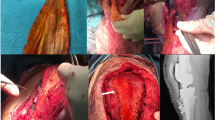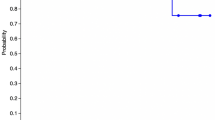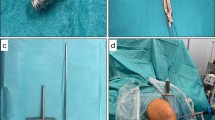Abstract
Purpose
Extensor mechanism lesion after total knee arthroplasty (TKA) is a catastrophic complication. Reconstruction with extensor mechanism allograft (EMA) has been described as a sound salvage procedure. Its effectiveness at long term and in septic cases is still under scrutiny. The long-term results of EMA reconstruction for chronic extensor mechanism failures following aseptic and septic revision TKA have been analysed.
Methods
From the institutional database, 35 patients with a revision TKA (RevTKA) undergoing EMA reconstruction from 2005 to 2015 have been retrospectively identified. A history of periprosthetic joint infection (PJI) was found in 13 (37%) patients. The mean follow-up was 81.2 months (± 34.7, range 3–120). EMA failures were considered for lag more than 20°, Knee Society Score (KSS) less than 60 points, and/or in the case of revision of the allograft.
Results
The mean KSS improved from 35.9 (± 16.9, range 0–54) to 86.6 (± 10.4, range 54–99) points in the aseptic group (p < 0.001) and from 27.5 (± 11.6, range 10–44) to 79.4 (± 16.3, range 48–94) points in the septic group (p < 0.001). The extensor lag changed from 48.4° (± 14.5, range 30–90) to 4.6° (± 10.8, range 0–50) in the aseptic group (p < 0.001) and from 56.5° (± 20.8, range 30–90) to 6.1° (± 6.8, range 0–20) in the septic group (p < 0.001). The mean postoperative flexion was 105.2° (± 13.2, range 75–130) in the aseptic group and 102.7° (± 12.5, range 80–120) in the septic group (p = 0.32). Three failures (14% of the cases) occurred in the aseptic group and five in the septic group (38% of the cases). The overall survivorship at 10 years was 83.3% (22 cases, CI95 94.2–121.7) vs 58% (13 cases, CI95 67.2–111.7) in the aseptic and septic group, respectively (p = 0.01).
Conclusions
EMA reconstruction after extensor mechanism disruptions in TKA is a reliable salvage procedure. The septic nature of the revision decreased the functionality of the knee joint after EMA, but it did not represent a risk factor for re-ruptures or recurrence of infection.
Level of evidence
Level III.


Similar content being viewed by others
Data availability
All the data of the present study are available on file under the archives of the corresponding author.
References
Abdel MP, Salib CG, Mara KC, Pagnano MW, Perry KI, Hanssen AD (2018) Extensor mechanism reconstruction with use of Marlex mesh: a series study of 77 total knee arthroplasties. J Bone Jt Surg Am 100(15):1309–1318
Abril JC, Alvarez L, Vallejo JC (1995) Patellar tendon avulsion after total knee arthroplasty. A new technique. J Arthroplasty 10(3):275–279
Brown NM, Murray T, Sporer SM, Wetters N, Berger RA, Della Valle CJ (2015) Extensor mechanism allograft reconstruction for extensor mechanism failure following total knee arthroplasty. J Bone Jt Surg Am 97(4):279–283
Browne JA, Hanssen AD (2011) Reconstruction of patellar tendon disruption after total knee arthroplasty: results of a new technique utilizing synthetic mesh. J Bone Jt Surg Am 93(12):1137–1143
Burnett RS, Berger RA, Paprosky WG, Della Valle CJ, Jacobs JJ, Rosenberg AG (2004) Extensor mechanism allograft reconstruction after total knee arthroplasty. A comparison of two techniques. J Bone Jt Surg Am 86(12):2694–2699
Busfield BT, Huffman GR, Nahai F, Hoffman W, Ries MD (2004) Extended medial gastrocnemius rotational flap for treatment of chronic knee extensor mechanism deficiency in patients with and without total knee arthroplasty. Clin Orthop Relat Res 428:190–197
Cadambi A, Engh GA (1992) Use of a semitendinosus tendon autogenous graft for rupture of the patellar ligament after total knee arthroplasty. A report of seven cases. J Bone Jt Surg Am 74(7):974–979
Chow S, Shao J, Wang H (2008) Sample size calculations in clinical research, 2nd edn. Chapman & Hall/CRC Biostatistics Series, p 52
Crossett LS, Sinha RK, Sechriest VF, Rubash HE (2002) Reconstruction of a ruptured patellar tendon with Achilles tendon allograft following total knee arthroplasty. J Bone Joint Surg Am 84(8):1354–1361
Deren ME, Pannu TS, Villa JM, Firtha M, Riesgo AM, Higuera CA (2021) Meta-analysis comparing allograft to synthetic reconstruction for extensor mechanism disruption after total knee arthroplasty. J Knee Surg 34(3):338–350. https://doi.org/10.1055/s-0039-1696656. (Epub 2019 Aug 30)
Emerson RH Jr, Head WC, Malinin TI (1994) Extensor mechanism reconstruction with an allograft after total knee arthroplasty. Clin Orthop Relat Res 303:79–85
Emerson RH Jr, Head WC, Malinin TI (1990) Reconstruction of patellar tendon rupture after total knee arthroplasty with an extensor mechanism allograft. Clin Orthop Relat Res 260:154–161
Grace JN, Rand JA (1988) Patellar instability after total knee arthroplasty. Clin Orthop Relat Res 237:184–189
Insall JN, Dorr LD, Scott RD, Scott WN (1989) Rationale of the knee society clinical rating system. Clin Orthop Relat Res 248:13–14
Jaureguito JW, Dubois CM, Smith SR, Gottlieb LJ, Finn HA (1997) Medial gastrocnemius transposition flap for the treatment of disruption of the extensor mechanism after total knee arthroplasty. J Bone Jt Surg Am 79(6):866–873
Lamberti A, Balato G, Summa PP, Rajgopa A, Vasdev A, Baldini A (2018) Surgical options for chronic patellar tendon rupture in total knee arthroplasty. Knee Surg Sports Traumatol Arthrosc 26(5):1429–1435
Leopold SS, Greidanus N, Paprosky WG, Berger RA, Rosenberg AG (1999) High rate of failure of allograft reconstruction of the extensor mechanism after total knee arthroplasty. J Bone Jt Surg Am 81(11):1574–1579
Lynch AF, Rorabeck CH, Bourne RB (1987) Extensor mechanism complications following total knee arthroplasty. J Arthroplasty 2(2):135–140
Nazarian DG, Booth RE Jr (1999) Extensor mechanism allografts in total knee arthroplasty. Clin Orthop Relat Res 367:123–129
Papalia R, Vasta S, D’Adamio S, Albo E, Maffulli N, Denaro V (2015) Complications involving the extensor mechanism after total knee arthroplasty. Knee Surg Sports Traumatol Arthrosc 23(12):3501–3515
Perry KI, Salib CG, Larson DR, Pagnano MW, Abdel MP, Hanssen AD (2018) Two-stage exchange and Marlex-mesh reconstruction for infection with extensor mechanism disruption after total knee arthroplasty. J Bone Jt Surg Am 100(17):1482–1489
Rand JA, Morrey BF, Bryan RS (1989) Patellar tendon rupture after total knee arthroplasty. Clin Orthop Relat Res 244:233–238
Ricciardi BF, Oi K, Trivellas M, Lee YY, Della Valle AG, Westrich GH (2017) Survivorship of extensor mechanism allograft reconstruction after total knee arthroplasty. J Arthroplasty 32(1):183–188
Wood TJ, Leighton J, Backstein DJ, Marsh JD, Howard JL, McCalden RW, MacDonald SJ, Lanting BA (2019) Synthetic graft compared with allograft reconstruction for extensor mechanism disruption in total knee arthroplasty: a multicenter cohort study. J Am Acad Orthop Surg 27(12):451–457. https://doi.org/10.5435/JAAOS-D-18-00393
Funding
The authors received no financial support for the research, authorship, and publication of this article.
Author information
Authors and Affiliations
Corresponding author
Ethics declarations
Conflict of interest
The authors declare that they have no conflict of interest.
Ethical approval
This study was approved by the local Ethics committee of the Azienda Ospedaliera Universitaria di Careggi, Florence Italy with ID 15366 of 13 October 2019.
Additional information
Publisher's Note
Springer Nature remains neutral with regard to jurisdictional claims in published maps and institutional affiliations.
Rights and permissions
Springer Nature or its licensor (e.g. a society or other partner) holds exclusive rights to this article under a publishing agreement with the author(s) or other rightsholder(s); author self-archiving of the accepted manuscript version of this article is solely governed by the terms of such publishing agreement and applicable law.
About this article
Cite this article
Baldini, A., Lamberti, A., Balato, G. et al. Inferior results at long-term follow-up after extensor mechanism allograft reconstruction in septic compared to aseptic revision total knee arthroplasty. Knee Surg Sports Traumatol Arthrosc 31, 1477–1482 (2023). https://doi.org/10.1007/s00167-022-07280-0
Received:
Accepted:
Published:
Issue Date:
DOI: https://doi.org/10.1007/s00167-022-07280-0




